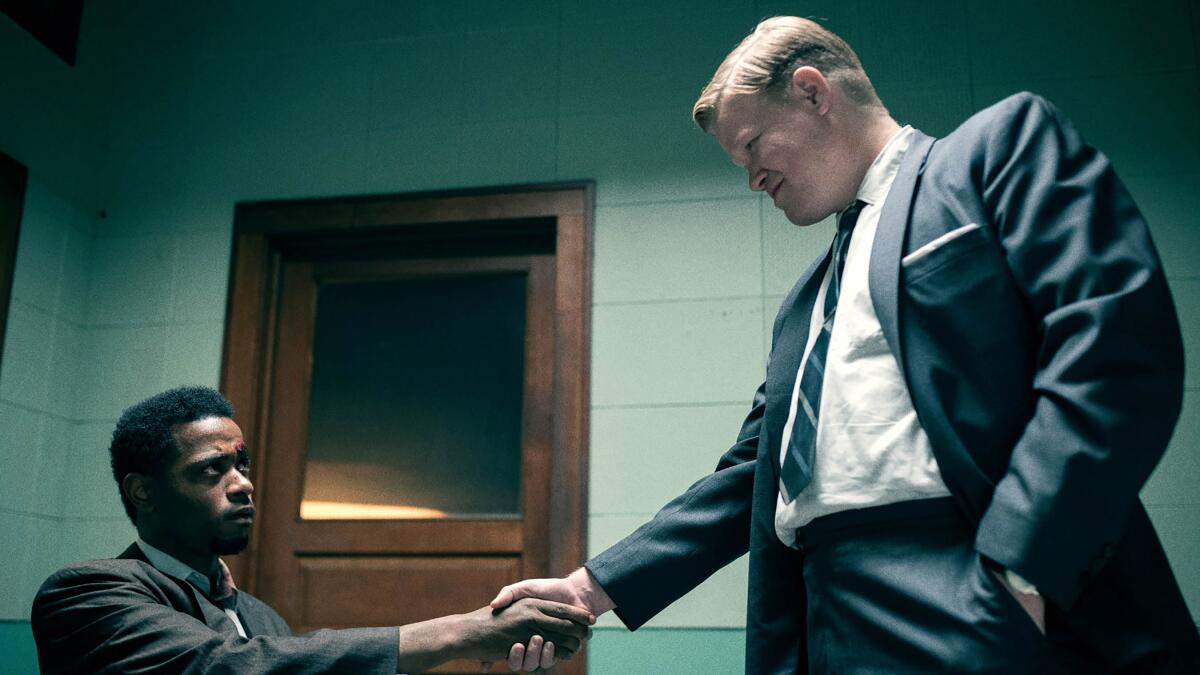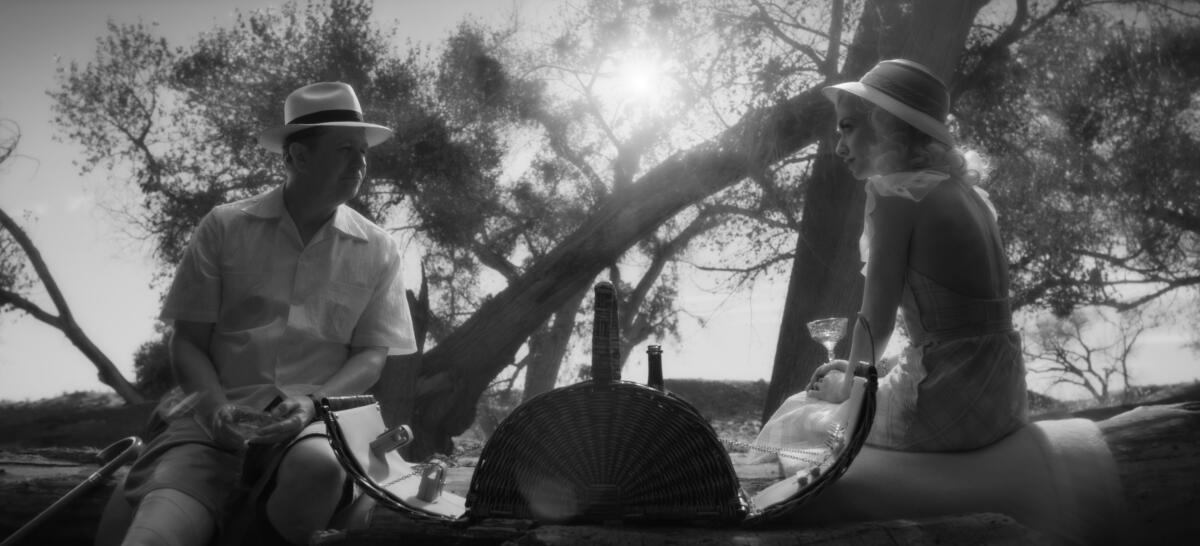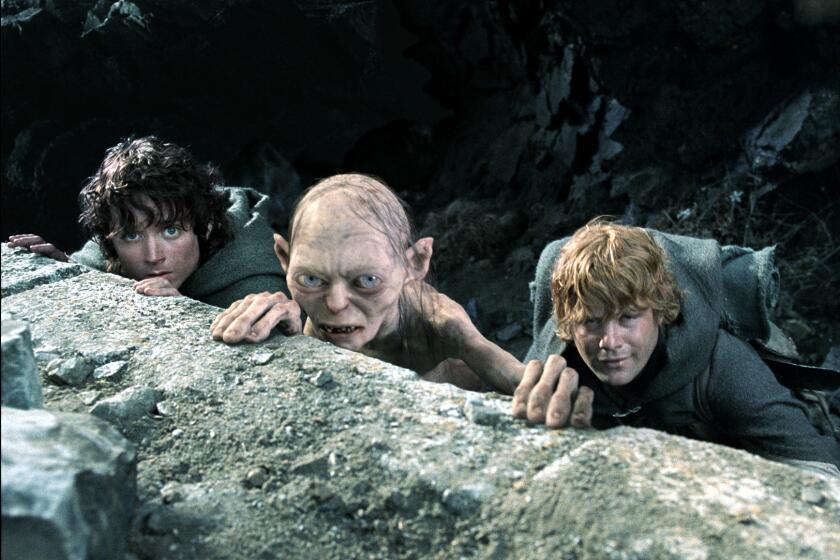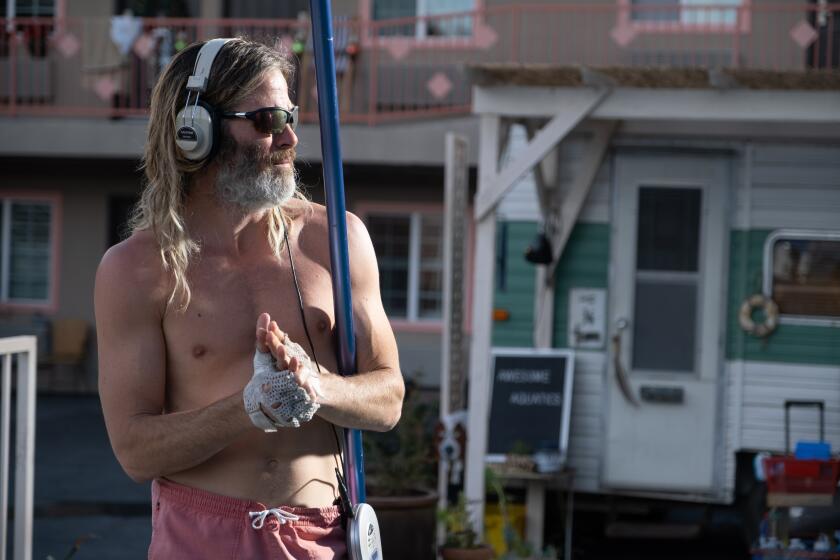There is an asterisk (*) next to this year’s Oscar race. But it’s not the one you think

When I saw “Minari” and “Promising Young Woman” early last year at their jam-packed premiere screenings at the Sundance Film Festival, I didn’t know I was seeing two future Oscar nominees for best picture. I also didn’t know it was the last time I’d see them on the big screen as their respective distributors, A24 and Focus Features, were forced to rethink their theatrical plans in the wake of the COVID-19 pandemic. Nor would I have guessed that more than a year later, the motion picture academy would nominate a slate of movies that had bypassed theaters almost entirely, one of the stranger wrinkles in an unprecedentedly strange season.
Looking over this year’s eight best picture nominees from that vantage, I can’t help but see my missed opportunities. At that same Sundance, I could have watched “The Father” in a theater and witnessed the undiminished power of not only Anthony Hopkins’ and Olivia Colman’s performances (rightly nominated on Monday morning), but also the deviously intricate pleasures of its production design (ditto). I wish too that I had heeded the excited refrain from my colleagues months earlier at Toronto — “Did you see ‘Sound of Metal’ yet?” — rather than catching up with it months later on a screener. Delighted as I am to see Riz Ahmed and especially Paul Raci nominated for Oscars today, I have only a partial appreciation of “Metal’s” beautifully detailed sound work, duly recognized in the academy’s sound category.
Watching both “The Trial of the Chicago 7” and “Judas and the Black Messiah” in my living room weeks ago, I couldn’t help but wonder how much more impact these two urgently bristling ensemble dramas — both steeped in the anguished headlines and fierce political protests of the late ’60s — might have generated in a packed theater, where you’d ideally bump elbows with your companions and lean forward so as not to miss a single furious line. Watching “Nomadland” at a pop-up drive-in at the Rose Bowl last fall was a trickier experience to parse: While my car was farther away from the screen than I would have liked, I had to admit that a parking lot was a gorgeously evocative venue for a movie largely set in parking lots.

Curiously enough, one of the few best picture nominees I did see on a big screen was a Netflix release. At the time of that private screening of “Mank,” I hadn’t seen a movie on a screen larger than my TV in months. And so this one — put on just for me and my masked face, with no digital screener watermark or pause button in sight — was an almost indecently luxurious experience. At a certain point, I stood up, walked around the empty screening room and basked in the black-and-white widescreen images of Gary Oldman and Amanda Seyfried (both nominated on Monday), looming over me as they strolled the grounds of Hearst Castle; I wanted to jump into the frame and join them. For that brief moment, David Fincher’s acerbic valentine to Old Hollywood became an elegy for a bygone way of moviegoing life.
With any luck, and with the pandemic in the early signs of retreat, some semblance of that life will eventually be restored. But until then, what to make of the bizarre anomaly of this past year and all the cinematic art — good, bad and mostly underseen — that emerged in its wake? Given how many movies were held back and how many others were drained of their expected impact, what does it mean to celebrate the art of filmmaking in 2021? The artists behind this year’s eight best picture nominees are surely grateful this morning for the recognition. I imagine more than a few of them might also have mixed feelings about the odd, contradictory circumstances that propelled them into the running.
Every year a handful of good and great movies, if they’re lucky, get nominated for major awards, broadening their audience exposure and deepening their cultural foothold. This past year, those footholds were harder to achieve and maintain, and the movies that made inroads did so through some tricky convergence of critical acclaim, word-of-mouth enthusiasm and streaming-platform accessibility. With few exceptions (like “Tenet,” a worthy Oscar nominee for visual effects and production design), they had to make do without the enormous, attention-grabbing screens that would show their particular achievements to the best possible advantage.

But a challenging year, I hasten to add, doesn’t mean an invalid one. In March 2020, when COVID lockdowns began and journalists started speculating about how this would impact the 2020-21 Oscar race (because it’s never too soon), more than a few observers suggested that said race would always have an asterisk next to it in the history books. For some that asterisk has been cause for dismissive condescension: This isn’t a “real year,” and there haven’t been any “real movies.” The academy’s decision to postpone the Oscars to April, in optimistic anticipation that more of those “real movies” might enter the race, would seem to bear out that assumption. To subscribe to this logic, of course, is to reveal little more than one’s own laziness and incuriosity about movies, which were not only very real this year but also remarkably abundant. (Three hundred sixty-six features were made eligible for best picture consideration this year, the highest number since 374 in 1970.)
My asterisk means something entirely different, and instructive. Without big-studio releases to drive and dominate the conversation on movies and without endless box office reporting to skew our accepted notion of which films matter, the academy was freed to look closer and harder at a number of titles — some featuring little-known actors and some performed in languages other than English — at which they may not have been otherwise inclined to look. Their choices don’t feel like some compromised, lesser thing; they feel refreshing, even clarifying. This asterisk denotes something exceptional.
The entirely welcome representational precedents set by this year’s slate — with two women director nominees, two director nominees of Asian descent and nine actor nominees of color in an altogether startling rebuke of #OscarsSoWhite — are more gratifying for seeming like a natural reflection of the talent on display rather than the result of some strained, tokenistic effort. The egalitarian sweep of this year’s nominees feels especially pronounced in the acting races, where household names like Anthony Hopkins, Frances McDormand and Glenn Close jostle alongside brilliant newcomers like Andra Day (“The United States vs. Billie Holiday”) and Maria Bakalova (“Borat Subsequent Moviefilm”), plus a South Korean veteran, Yuh-Jung Youn, who was little-known in the U.S. before “Minari.”

Elsewhere, too, could be found a spirit of collective discernment — or perhaps “Collective” discernment, given the worthy documentary feature and international feature nominations for Alexander Nanau’s harrowing nonfiction thriller. (It was nice to see the academy finally acknowledge that Romania is home to some of our most astute and gifted filmmakers.) While I don’t expect (or want) Chloé Zhao’s “Nomadland” winning streak to break on Oscar night, I’m still popping a Champagne cork for Danish filmmaker Thomas Vinterberg, whose international feature contender “Another Round” cracked the competitive director race — a delightful surprise that I’m not entirely sure should be attributed to pandemic weirdness, given that the directors branch has long been the academy’s most adventurous and internationally-minded faction.
In the best picture category, meanwhile, the academy selected a well-balanced final eight that, whatever its omissions and missteps, can easily stand shoulder-to-shoulder with any slate from the past several years and frankly shames a couple of the others. It could be the most internally consistent lineup in years; true, there may be nothing in the mix as sublime as “Moonlight” or as thrilling as “Mad Max: Fury Road,” though I would counter that neither is there anything as objectionable as “Jojo Rabbit” or “Bohemian Rhapsody.”
True, the academy didn’t get everything right, though everyone will of course have a different idea of what that means. My list of unsurprising disappointments begins with the omission of Kelly Reichardt’s quietly masterful “First Cow,” which suggests there are limits to the academy’s discernment, particularly when it comes to movies that choose not to declaim but to whisper. The academy’s bountiful admiration for “Minari” (whose Oscar-nominated director Lee Isaac Chung is, full disclosure, a friend) feels rather less coherent when you factor in those nominations for “Hillbilly Elegy,” a rather more embarrassing portrait of rural America with a salty-mouthed grandma at its center.

I was pleased to see a best-picture nomination for “Judas and the Black Messiah,” a late-breaking favorite that proved popular enough with voters to sweep LaKeith Stanfield into the supporting actor race, landing alongside his co-star and the presumed frontrunner, Daniel Kaluuya. But the strong showing for Shaka King’s electrifying drama only served to compound the disappointment of many that only one of this year’s strong, majority-Black ensemble dramas was deemed worthy of recognition for best picture, excluding “Da 5 Bloods,” “One Night in Miami … ” and “Ma Rainey’s Black Bottom.” (The latter two at least scored acting nominations; the lack of a lead actor nomination for Delroy Lindo’s stellar work in “Da 5 Bloods” was widely singled out as the morning’s biggest outrage.)
The work of discernment, in other words, is never finished. But that doesn’t mean it isn’t in progress. What if, instead of regarding the 2020-21 awards season as a weird blip to be dispensed with and forgotten about as quickly as possible, we lifted it as a flawed but vital next step toward the fulfillment of an ideal? What if we eagerly looked ahead to the rewards of a post-pandemic cinema — to the pleasures of being together again in packed, thriving movie houses — without abandoning the idea that some of the best pictures might actually be playing to smaller crowds? A great film, it bears remembering, can come from anywhere.
Even if it really should be seen in a theater.
More to Read
Only good movies
Get the Indie Focus newsletter, Mark Olsen's weekly guide to the world of cinema.
You may occasionally receive promotional content from the Los Angeles Times.







